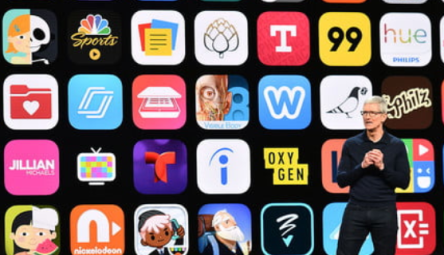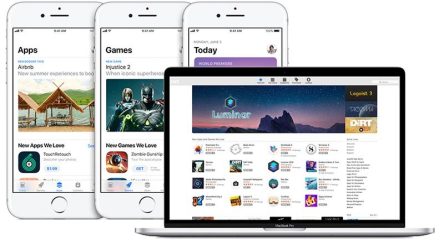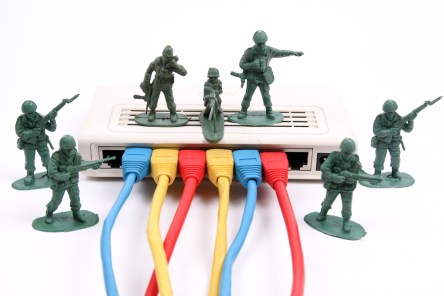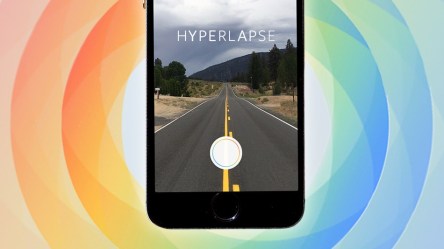This year’s Apple WWDC keynote, held at the San Jose McEnergy Convention Center in San Jose, was a big surprise for many, not for what it showcased, but for what it didn’t—hardware. Even though the event is clearly about software, Apple has gotten us used to announcements of future or refreshes of current products. But this year’s session was all about a large variety of enhancements to its iOS, tvOS, watchOS and MacOS platforms, designed to further optimize the overall Apple experience. News on hardware will reportedly be announced in September. iOS improvements include faster speeds and enhanced responsiveness for the iPhone. This even applies to the older versions, like the 6S, which the company claims will fire up 50 percent faster than previously with its camera will be ready to snap photos 70 percent faster than before. iOS 12 should work just fine on all devices capable of running iOS 11, including the little 5S. This was pleasant news for those hanging on to older phones. Maybe the nicest touch added to the operating system is Screen Time, which could help curb smartphone overuse. New usage reports will show how you’re wasting your time and, should you want to, you can set limits for those apps that eat up too much of your time. Grouped notifications are an attempt to cut distractions, and parents will be able to limit their child’s screen time. For many, this announcement was bizarre as it is unheard of to have a company use one of its biggest annual events to showcase ways to use its products less. But the reality is that Apple doesn’t make money from the time people spend on its devices, it just needs as many people as possible to buy those devices. If...
Apple’s Marzipan
A Dream Come True?
The iPhone is Apple’s most popular product, with superb design and flawless operating system. The Mac is a beautiful and powerful machine that turns working into fun. iPhones and Macs, as members of the same product family, communicate nicely through continuity module, but there’s one more thing that could make the experience even better. In fact, Apple users have been dreaming about this for a very long time. The unification of iOS and macOS becomes a dream as soon as one joins the ranks of Mac users. It’s sad to see how few apps made it to the Mac thus far. Since last December, rumor has it that Apple is almost ready to fulfill this desire. A Bloomberg report claims that Apple has an internal project, dubbed Marzipan, that seeks to make it possible for app developers to publish apps that will work on both the mobile iOS devices and on Mac computers. But here people have different opinions on how, if at all, this will roll out. Blurring the lines between iOS and macOS is anticipated to occur this year at the next major software kicks in. If Apple decides to stick to its usual release pattern, we’re looking at iOS 12 and macOS 10.14 (some say that Apple might even rename it all together and go with macOS 11 for such a big update). The update is anticipated to be launched at WWDC in June, following to launch to the public in September. Until then, we will stockpile our questions. The first set of questions that comes to mind has to do with the concepts of each OS: iOS doesn’t have a mouse cursor and runs only on touchscreen devices, while macOS has no support for touchscreen devices and needs a mouse...
Rogue Routers
Smart Home Security
The smart home’s weakest link may be that unassuming router tucked neatly next to your modem. [Update: Netgear has released firmware updates for the affected products. Click here for more information.] While the breach of one billion Yahoo! Email accounts continues to dominate the new, another internet security crisis continues unabated. As Lily Hay Newman reports in Wired’s latest issue, Nighthawk line of Netgear routers can be remotely exploited, allowing third-parties to take control of the devices, leaving thousands of home networks open to hackers and “”havoc-wreaking botnets.” “While Netgear has finally released a tentative fix for some models,” writes Newman, “the delays and challenges in patching all of them help illustrate just how at risk the Internet of Things is—and how hard it is to patch up when things go wrong.” Hacking the Home Like many of the smart devices that make up the “Internet of Things,” routers seem as common – and as low-tech – as a toaster or thermostat. But as has already been noted, the ubiquitous nature of many of these ‘wired” versions of our beloved devices make them almost invisible; and for many smart home inhabitants, invisibility is a weakness. “If we want to put networked technologies into more and more things, we also have to find a way to make them safer,” Michael Walker, program manager and computer security expert for the Pentagon’s advanced research arm recently told the New York Times. “It’s a challenge for civilization.” Routers Gone Wrong Andrew Rollins, a security researcher with the handle Acew0rm, notified Netgear about the security flaw back in August but never heard back from the company. As months went by with no fix – presumably exposing thousands of users in the interim – Rollins eventually chose to go public....
Watch Works
Wearable for Seniors
With its user-friendly interface and advanced health and safety features, the Apple Watch Series 2 may be the perfect wearable for senior citizens. While wireless earbuds, dual cameras and the death of the audio jack dominated the post-game analysis of Apple’s 2016 Keynote, the Apple Watch updates demonstrate the genuine potential of today’s wearable technology, especially for senior citizens. While the first Apple Watch proved a bit of a disappointment, the Series 2 raises the bar with enhanced functionality and modern design. Combined with an updated watchOS and a slew of new apps, the Apple Watch Series 2 provides health and safety options perfectly attuned to the needs of today’s aging population. Safe and Sound The original Apple Watch arrived with plenty of choices for security-minded users. Over the last year, developers have been hard at work designing emergency alert apps. Dialing 911 during an emergency may seem relatively straightforward, but apps like HelpAround provide a sort of panic button that notifies authorities and a list of designated contacts when activated. Now the watch itself makes it even easier to reach out during a catastrophe. Pressing and holding the side button activates the watch’s SOS function, placing an immediate call to 911. The watch then automatically sends a message to designated contacts with location information and a map. After the call, the watch itself will display medical ID information, including age and allergies and other important information. The flashiest Apple Watch upgrades announced at the keynote include waterproofing and a new ceramic body almost impervious to the dents and scratches that plague most wearable devices. In terms of safety and security, but the device’s built-in GPS is what really shines. By incorporating the watchOS maps, the Series 2 can also display routes and maps...
Instagram Hyperlapse
Easy Mobile Video
If you haven’t looked into Instgram now is the perfect time to reconsider. Instagram has launched its standalone companion, Hyperlapse, to appeal to the Vine crowd without…well, the Vine crowd. Hyperlapse offers mobile video production that’s quick, simple, and eye catching. In other words, it’s just what you need to take your content marketing to the next level. Hyperlapse helps mobile users create silent videos that are 15 seconds in length or fewer. This is more than double the video length available on Vine, allowing you to offer a fuller presentation of your content while maintaining your audience’s short attention span. Effortlessly create seamless video tours of a unit or longer videos showing what the surrounding community has to offer. It’s also a good tool for sharing clips from community events. Anyone can create a good video with Hyperlapse thanks to the ultra-simple process: record up to 45 minutes of video, alter speed as needed, save, and share. Your staff won’t need a media degree or innate tech-savviness to operate the app. Hyperlapse is just that straightforward. While simplicity is an excellent feature, it’s the quality of Hyperlapse videos that will really make your content stand out. Built-in image stabilization (via the phone’s gyroscopes) gives the videos a smooth, professional finish rather than looking like bumpy scenes from The Remaining. This app can potentially save you money. Create awesome videos with fewer calls to your professional videographer. Prospective users will be glad to know that you don’t have to create a new presence on the app. It’s a pain to build and maintain a following on a new social media platform, especially when we don’t know which apps will be hot or not in the next six months. Hyperlapse cuts the drama by allowing you to...
Mobile OS Race
The race for 3rd place
The mobile ecosystem is constantly making room for innovation and new applications. Smartphone operating systems are racing for market position. At the moment, a duopoly is in place: Linux-based Android, followed closely by Apple’s iOS. The third spot is under contention between Microsoft’s Windows, Blackberry’s Blackberry 10, and Firefox’s Firefox OS. Who will occupy the bronze podium and what’s their impact on the market? Gartner tracks technology shipments and predicts that the worldwide PC market will drop 7.6 percent this year, due to user behavior. Customers are flocking to mobile, an economically favorable alternative to a laptop/PC, and application addiction is very real. Tablets will see a 69.8 percent increase in shipments from 2012 and smartphones will grow from 675 million to 1 billion units, according to Gartner’s data research. Google’s free Android is currently the most popular smartphone OS, holding two thirds of the market. Trying to ensemble the intuitive, easy and delightful experience iOS offers, combined with the power and flexibility of the traditional Windows desktop OS, Android became the “Windows” of mobile operating systems. With multiple manufacturers, each with their own price, quality level, and features, Android is much easier to customize, being extremely flexible. Today there’s a device running on Android for every pocket, purpose, and desire. Apple’s iOS, not even available for licensing, has less than one third of the market; its iOS platform is by far the most polished, prestigious and popular of them all. After all, it’s Apple that kicked off the modern post-PC era. iOS is reliable, its hardware is gorgeous and cutting–edge, and iTunes is the largest library of apps and content. It’s so easy to use an iPad, that everyone can understand how it works, even toddlers. For the average consumer with little to...






